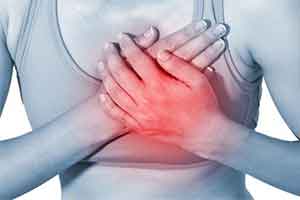Cardiovascular disease kills 51% of women in Europe and breast cancer kills 3%
 Cardiovascular disease (CVD) kills 51% of women in Europe and breast cancer kills 3%, bucking the misperception that CVD is a man’s disease. CVD is the top killer in women and is largely preventable. The call for women to reduce their risk comes from the European Society of Cardiology (ESC) on International Women’s Day.
Cardiovascular disease (CVD) kills 51% of women in Europe and breast cancer kills 3%, bucking the misperception that CVD is a man’s disease. CVD is the top killer in women and is largely preventable. The call for women to reduce their risk comes from the European Society of Cardiology (ESC) on International Women’s Day.
Dr Susanna Price, ESC spokesperson and consultant cardiologist at the Royal Brompton Hospital in London, UK, said: “CVD is still largely considered a man’s problem with breast cancer commonly perceived as the greater issue for women. However, CVD is the top killer of women in Europe, resulting in 51% of deaths compared to 3% caused by breast cancer.”
She added: “Women’s risk of heart disease tends to be underestimated by both the public and the medical profession because of the perception that oestrogen protects them. In reality this just delays the onset of CVD by 10 years. The result is that women’s risk factors are left untreated, leaving them more vulnerable to heart attack, heart failure and sudden cardiac death when the protection fades after menopause.”
Despite these misconceptions, the facts are that:
• CVD is the main cause of death in women in all countries of Europe
• CVD causes 51% of deaths in women and 42% of deaths in men in Europe
• CVD kills 51% of women in Europe and breast cancer causes 3% of deaths
• The risks of smoking are higher in women because women metabolise nicotine faster, especially those taking oral contraceptives
• Type 2 diabetes doubles CVD risk in men but more than triples the risk in women
• Women are more likely to be severely disabled after a stroke than men
“Another reason CVD is under-recognised and under-treated in women is that they can have different or atypical symptoms,” said Dr Price. “Instead of chest pain, women having a heart attack may experience nausea/vomiting, shortness of breath, jaw pain, fatigue, palpitations, syncope (fainting) or cardiac arrest. They need to call the emergency number urgently as soon as the symptoms of a heart attack or stroke start.”
Stroke symptoms include sudden numbness or weakness of the face, arm and/or leg, especially on one side of the body, sudden confusion, trouble seeing, dizziness or sudden severe headache with no known cause.
The effects of CVD are often worse in women than in men. Women are more likely to be severely disabled after a stroke than men, and although they receive greater benefit from clot busting drugs (thrombolysis), fewer receive them. This could be because the drugs are most effective 3-6 hours after symptoms begin and women are less likely than men to reach the hospital within this time period.
Compared to men, women less often know the risk factors and take part in screening. Worryingly, the risks of smoking are higher in women because they metabolise nicotine faster, especially those taking oral contraceptives. Dr Price said: “In common with men, women can reduce their risk of CVD by not smoking, being active, having a healthy body weight, getting their blood pressure and cholesterol checked and taking treatment if levels are high.”
However, women are less likely to receive proven therapies than men, including aspirin, statins, coronary revascularization after an acute coronary event (8) and oral anticoagulants to prevent stroke when they have atrial fibrillation, despite their higher risk.
Women may respond differently to therapy because they have different hormone levels, lower body weight and a higher percentage of body fat. For example aspirin reduces the risk of stroke but does not affect the occurrence of myocardial infarction in women, while in men aspirin reduces the risk of myocardial infarction with a non-significant increase in the risk of stroke. (5) But Dr Price said: “In many cases the safety and effectiveness of treatments in women are unknown because they have been tested mainly in men. Clinical trials are needed that include only women and/or more equal proportions of both sexes.”
She concluded: “CVD is by far the biggest cause of death in women but is still underestimated as a health problem for them. Greater awareness is needed by women and the medical profession to ensure that women reduce their risk factors and decrease their chances of having a heart attack and stroke.”
Source: European Society of Cardiology (ESC)

